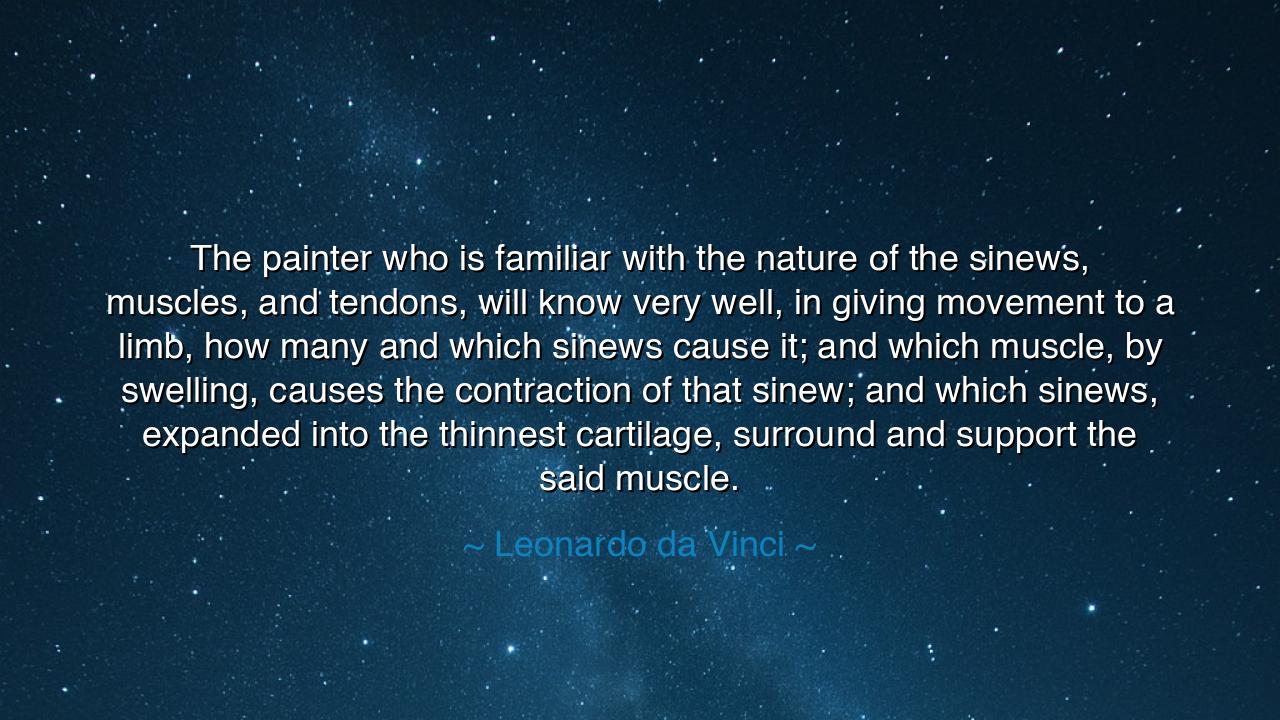
The painter who is familiar with the nature of the sinews
The painter who is familiar with the nature of the sinews, muscles, and tendons, will know very well, in giving movement to a limb, how many and which sinews cause it; and which muscle, by swelling, causes the contraction of that sinew; and which sinews, expanded into the thinnest cartilage, surround and support the said muscle.






Hear now the words of Leonardo da Vinci, master of both art and science, who proclaimed: “The painter who is familiar with the nature of the sinews, muscles, and tendons, will know very well, in giving movement to a limb, how many and which sinews cause it; and which muscle, by swelling, causes the contraction of that sinew; and which sinews, expanded into the thinnest cartilage, surround and support the said muscle.” These words carry the fragrance of wisdom, for they reveal the union of observation and creation, of knowledge and beauty.
The meaning is this: the true painter does not stop at the surface, content with lines and colors that deceive the eye. He goes deeper, into the nature of the body, into its hidden workings. He studies how a limb bends, not by imagination alone, but by the living truth of sinews pulling and muscles swelling. Thus his art is not illusion but revelation; he paints not a mask, but life itself. The ancients would call this the marriage of form and essence, of appearance and truth.
In these words we hear Leonardo’s creed: that art must be born of science, and science clothed in art. For he spent long nights dissecting the dead, sketching the architecture of flesh, tendon, and bone. His drawings of the human body, precise and beautiful, endure as both medical study and artistic wonder. He knew that to capture the divine grace of a moving arm or the tension of a straining neck, the painter must first honor the hidden laws that make such movements possible. Knowledge, he taught, is the root from which beauty grows.
Consider the story of Michelangelo painting the Sistine Chapel. To create his monumental figures, he too studied anatomy with passion, cutting into the flesh of the dead to learn how life itself was shaped. The mighty form of Adam reaching toward the finger of God, the rippling prophets, the twisting sibyls—all reveal this hidden study. Without understanding the play of muscles and the pull of tendons, their grandeur would be lifeless. With knowledge, they became immortal. Thus history shows that the greatest works arise not from imagination alone, but from imagination anchored in truth.
Yet there is more here than guidance for painters alone. Leonardo’s words speak to all pursuits: if you would build, understand the stone; if you would write, understand the soul; if you would lead, understand the heart of man. To master anything, you must go beneath the surface, into the structure that supports it. For appearances deceive, but the hidden mechanics—whether of body, spirit, or society—are where true wisdom lies.
This truth carries a warning. Many are content with shallow knowledge, with the quick sketch, the rough outline. But such works do not endure. Only that which is grounded in deep understanding will last the trials of time. Just as the body collapses without the harmony of sinews and muscles, so too does any art, science, or life collapse if it neglects the foundations upon which it rests. The wise do not hurry past these foundations, but study them with reverence.
Therefore, the lesson is clear: if you would create, if you would master, learn first to observe. Study the hidden structures of your craft. Do not despise detail, for detail is the doorway to truth. And once you have gathered knowledge, let it flow into beauty, as Leonardo did—so that your work may carry both accuracy and soul, both strength and grace.
So let the words of Leonardo da Vinci echo in your heart: “The painter who knows the sinews and muscles will give true movement to the body.” In them lies the eternal law: that to reveal life, one must first understand it. Walk this path of patient study and passionate creation, and your works too will breathe with the living truth of nature.






AAdministratorAdministrator
Welcome, honored guests. Please leave a comment, we will respond soon